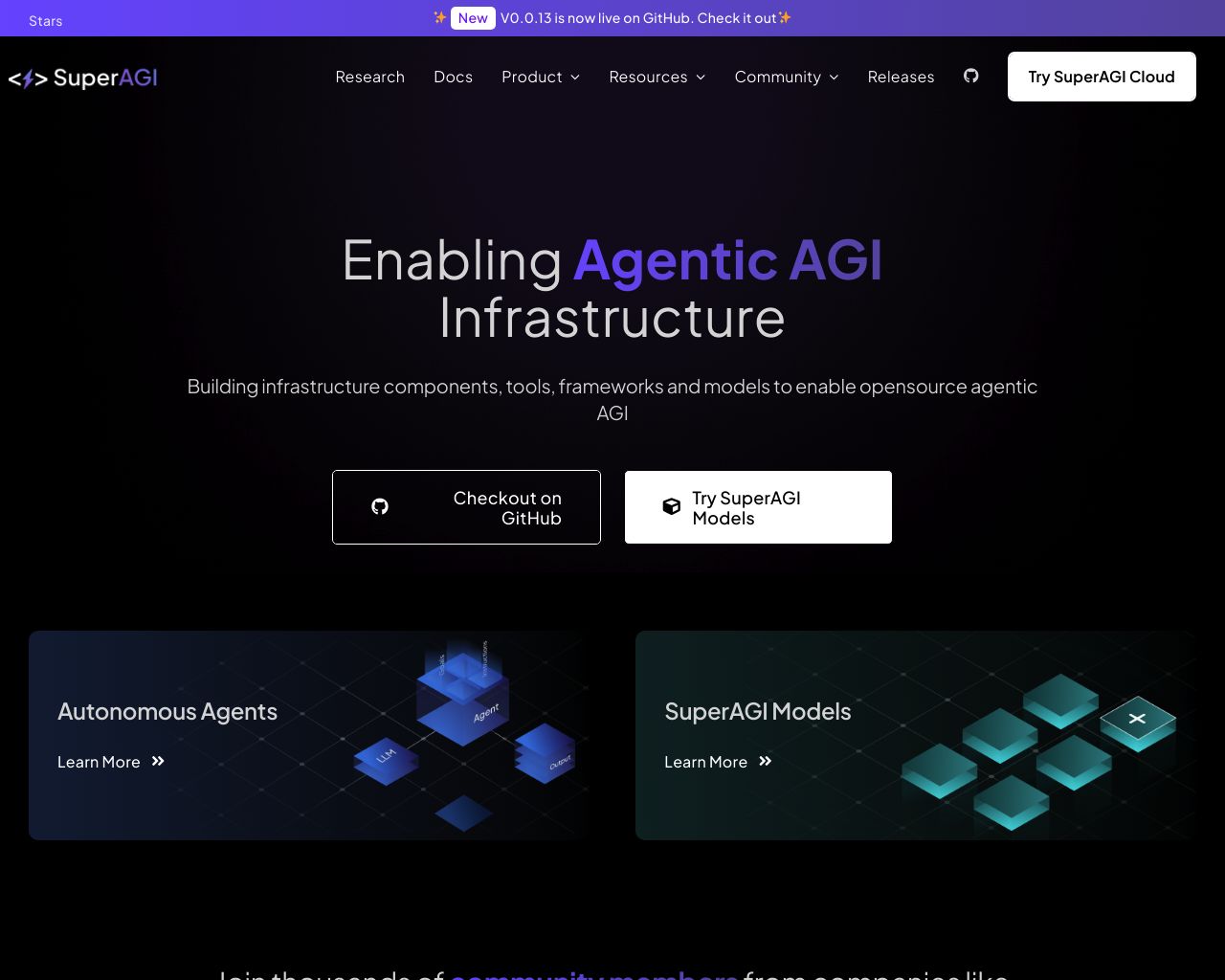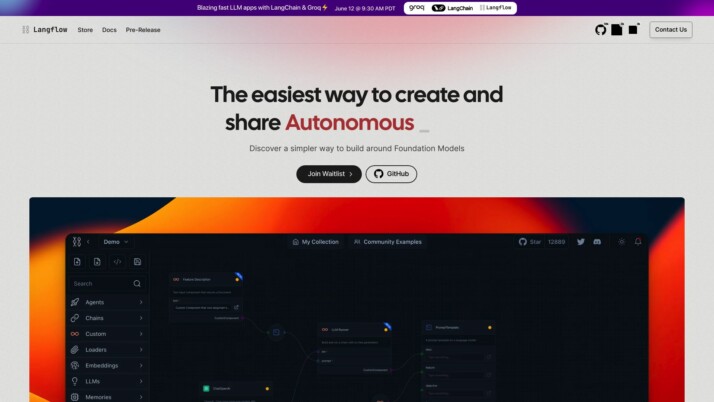SuperAGI vs. Langflow: Comparing AI Agent Development Platforms
The AI agent development landscape brims with innovative solutions, each offering unique approaches to harnessing artificial intelligence. This comparison delves into SuperAGI, an open-source framework for building autonomous AI agents, and Langflow, a low-code platform simplifying AI workflow creation. We’ll explore how these tools stack up in features, ease of use, and overall capabilities, while introducing SmythOS as a compelling alternative that combines powerful functionality with user-friendly design. Whether you’re a seasoned developer seeking advanced AI capabilities or a business professional looking to integrate AI into your workflows, this review provides crucial insights to guide your choice in AI agent development platforms.
SuperAGI Overview
SuperAGI stands out as an open-source autonomous AI agent framework, empowering developers to create, manage, and deploy intelligent agents across various environments. This platform leverages advanced technologies like Large Language Models (LLMs) and Large Action Models (LAMs) to enable the development of highly capable AI systems.
At its core, SuperAGI offers a comprehensive suite of tools for building autonomous agents that can reason, perform tasks, and make decisions independently. The framework supports both development and production environments, facilitated through Docker and GitHub Codespaces, allowing for seamless transition from testing to deployment.
SuperAGI excels in providing robust features for agent memory storage, activity monitoring, and performance telemetry. These capabilities enhance the agents’ ability to learn, adapt, and improve over time. The platform’s support for concurrent agent execution and integration with a wide range of tools—including Slack, GitHub, and Zapier—sets it apart from similar frameworks.
SuperAGI offers a comprehensive suite of tools for building autonomous agents that can reason, perform tasks, and make decisions independently.


While SuperAGI offers powerful features for developers, it lacks certain elements that could enhance its accessibility. The absence of a visual builder or no-code editor might pose challenges for users without extensive programming experience. Additionally, the platform does not explicitly mention data encryption features, which could be a concern for organizations handling sensitive information.
SuperAGI’s commitment to advancing autonomous software development and generalized AI is evident in its research focus areas, including neurosymbolic AI and recursive self-improvement systems. The platform’s open-source nature and collaborations with industry leaders underscore its potential to drive innovation in AI agent development. However, users should consider their specific needs and technical expertise when evaluating SuperAGI as a solution for their AI agent building requirements.
Langflow Overview
Langflow stands out as a low-code platform designed to simplify AI application development. This open-source tool bridges the gap between complex AI workflows and user-friendly interfaces, making AI integration accessible to a broader audience. Langflow’s visual approach to AI development allows users to create everything from basic tasks to intricate workflows without extensive coding knowledge.


Screenshot of Langflow Website
At its core, Langflow offers a drag-and-drop interface that leverages pre-built LangChain components, including Large Language Models and agents. This visual builder empowers users to construct AI workflows intuitively, experimenting with different configurations and prototyping ideas rapidly. The platform’s design philosophy centers on democratizing AI development, enabling both technical and non-technical users to harness the power of artificial intelligence.
Langflow stands out as a low-code platform designed to simplify AI application development… making AI integration accessible to a broader audience.
Langflow’s feature set extends beyond its visual interface. The platform includes a robust Command-Line Interface (CLI) for advanced users, providing granular control over project settings and configurations. Security remains a priority, with enhanced login mechanisms and customizable authentication options, particularly valuable for public deployments. Langflow also facilitates API integration, allowing programmatic access to components and workflows, and supports asynchronous processing for efficient resource management.
Langflow excels in customization, allowing users to create bespoke components using Python scripts. This flexibility enables the tailoring of the platform to specific needs, integrating unique functionalities seamlessly into the Langflow ecosystem. Additionally, the platform offers chat interface integration and embeddable chat widgets, facilitating the creation of interactive AI experiences within web applications.
While Langflow’s low-code approach and extensive pre-built components make it accessible, potential users should consider the learning curve associated with AI workflows. The platform may not offer the same level of control as high-code solutions for highly specific needs, and scalability concerns might arise for large-scale deployments or very complex workflows. Despite these considerations, Langflow’s vision of democratizing AI development positions it as a valuable tool for those looking to leverage AI technologies effectively, regardless of their technical background.
Feature Comparison
SuperAGI and Langflow offer contrasting approaches to AI agent development, with significant feature gaps in core components and security. SuperAGI focuses on autonomous AI agents capable of independent reasoning and decision-making, supporting both development and production environments. It excels in agent memory storage, activity monitoring, and performance telemetry, enhancing agents’ ability to learn and adapt over time.
Langflow, in contrast, provides a low-code platform with a drag-and-drop interface, making AI workflow creation accessible to users with varying technical backgrounds. While SuperAGI lacks a visual builder, Langflow’s intuitive interface allows for rapid prototyping and experimentation. However, Langflow falls short in autonomous agent capabilities and multi-agent collaboration, areas where SuperAGI shines.
In terms of security, SuperAGI offers constrained alignment features to ensure agents operate within predefined guidelines, but lacks explicit data encryption capabilities. Langflow prioritizes security with enhanced login mechanisms and customizable authentication options, particularly valuable for public deployments. Neither platform mentions specific IP control features, highlighting a potential security gap for both. These distinctions underscore the importance of carefully evaluating each platform’s strengths and limitations when choosing an AI agent builder for specific project requirements.
Feature Comparison Table
| SuperAGI | Langflow | SmythOS | |
|---|---|---|---|
| CORE FEATURES | |||
| Visual Builder | ❌ | ✅ | ✅ |
| No-Code Options | ❌ | ✅ | ✅ |
| Problem-Solving Capabilities | ✅ | ❌ | ✅ |
| Work as Team | ✅ | ❌ | ✅ |
| Bulk Work | ✅ | ❌ | ✅ |
| Agent Work Scheduler | ✅ | ❌ | ✅ |
| SECURITY | |||
| Data Encryption | ✅ | ❌ | ✅ |
| IP Control | ❌ | ❌ | ✅ |
| COMPONENTS | |||
| Foundation AIs | ✅ | ❌ | ✅ |
| All other APIs, RPA | ✅ | ❌ | ✅ |
| Data Lakes | ❌ | ✅ | ✅ |
| DEPLOYMENT OPTIONS (EMBODIMENTS) | |||
| Deploy as API | ✅ | ❌ | ✅ |
| Staging Domains | ❌ | ✅ | ✅ |
| Production Domains | ✅ | ❌ | ✅ |
| API Authentication (OAuth + Key) | ✅ | ❌ | ✅ |
| Deploy as Site Chat | ✅ | ❌ | ✅ |
| Deploy as GPT | ✅ | ❌ | ✅ |
| DATA LAKE SUPPORT | |||
| Sitemap Crawler | ❌ | ❌ | ✅ |
| YouTube Transcript Crawler | ❌ | ❌ | ✅ |
| URL Crawler | ✅ | ❌ | ✅ |
| PDF Support | ✅ | ❌ | ✅ |
Best Alternative to SuperAGI and Langflow
SmythOS stands out as the superior alternative to SuperAGI and Langflow, offering a comprehensive platform for AI agent development and deployment. We combine the strengths of both competitors while addressing their limitations, providing a powerful solution for businesses and developers alike.
Our visual builder surpasses Langflow’s low-code approach, offering intuitive drag-and-drop functionality alongside advanced customization options. This empowers users of all skill levels to create sophisticated AI workflows without sacrificing flexibility. Unlike SuperAGI’s focus on autonomous agents, we provide a balanced approach that supports both autonomous operation and fine-grained control, ensuring AI solutions align perfectly with your specific needs.
SmythOS stands out as the superior alternative to SuperAGI and Langflow, offering a comprehensive platform for AI agent development and deployment.
SmythOS excels in multi-agent collaboration, a critical feature lacking in Langflow. Our platform enables teams of AI agents to work together seamlessly, tackling complex tasks with unprecedented efficiency. We also offer robust problem-solving capabilities, matching SuperAGI’s strengths while providing a more user-friendly interface for implementation.
Security is paramount in AI development, and SmythOS delivers where our competitors fall short. We offer comprehensive data encryption, IP control, and OAuth authentication, ensuring your AI agents and sensitive data remain protected. This enterprise-grade security, combined with our scalable infrastructure, makes SmythOS ideal for businesses of all sizes, from startups to large corporations.
With SmythOS, you’re not limited to a single deployment option. We support a wide range of embodiments, including APIs, webhooks, chatbots, and even GPT integrations. This versatility, coupled with our extensive integration ecosystem, allows you to seamlessly incorporate AI agents into your existing workflows and systems, maximizing the impact of your AI investments.
Conclusion
SuperAGI and Langflow offer distinct approaches to AI agent development, each with unique strengths. SuperAGI excels in creating autonomous AI agents capable of independent reasoning and decision-making, while Langflow provides an accessible low-code platform for AI workflow creation.
Despite their individual merits, SmythOS emerges as the superior choice for businesses and developers seeking a comprehensive AI agent solution. Our platform combines the best of both worlds, offering powerful autonomous agent capabilities with an intuitive drag-and-drop interface. SmythOS’s extensive integration ecosystem, supporting over 300,000 integrations, surpasses both SuperAGI and Langflow in versatility and scalability.
Unlike SuperAGI’s lack of a visual builder or Langflow’s limited functionality compared to high-code solutions, SmythOS provides a perfect balance of user-friendliness and advanced capabilities. Our platform’s “Create Once, Deploy Anywhere” approach allows for seamless deployment across various environments, from APIs to chatbots and scheduled agents. This flexibility, combined with robust security features and scalability, positions SmythOS as the ideal choice for businesses of all sizes.
To experience the future of AI agent development, create a free SmythOS account today. Our risk-free trial allows you to build unlimited AI agents and explore our platform’s full potential. For those seeking inspiration, check out our diverse range of AI-powered agent templates to jumpstart your projects. Join the AI revolution with SmythOS and transform your business processes with intelligent, versatile, and easily deployable AI agents.
Last updated:
Disclaimer: The information presented in this article is for general informational purposes only and is provided as is. While we strive to keep the content up-to-date and accurate, we make no representations or warranties of any kind, express or implied, about the completeness, accuracy, reliability, suitability, or availability of the information contained in this article.
Any reliance you place on such information is strictly at your own risk. We reserve the right to make additions, deletions, or modifications to the contents of this article at any time without prior notice.
In no event will we be liable for any loss or damage including without limitation, indirect or consequential loss or damage, or any loss or damage whatsoever arising from loss of data, profits, or any other loss not specified herein arising out of, or in connection with, the use of this article.
Despite our best efforts, this article may contain oversights, errors, or omissions. If you notice any inaccuracies or have concerns about the content, please report them through our content feedback form. Your input helps us maintain the quality and reliability of our information.
